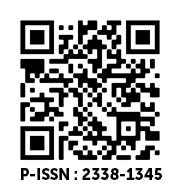Quail Production Systems, Prospects and Constraints in Ghana
DOI:
https://doi.org/10.36782/apjsafe.v10i2.173Keywords:
Quail, Production, Ecology, Breeds, eggsAbstract
ABSTRACT
This study was undertaken to assess the production systems, prospects and challenges of quail farming in three (3) ecological zones (Rainforest, Transitional and Guinea Savannah) in Ghana. Sixty (60) quail farmers were purposefully sampled for the study using the snowball sampling technique. Data were gathered through interviews with the aid of structured questionnaire and analysed using SPSS 22.0. The results showed that more males (86.7%) than females (13.3%) were involved in quail farming in Ghana with majority (73.3%) of farmers having less than five years of experience in the business. About 50% of quail farmers had their flock sizes ranging from 501 to 2000 birds. Three (3) major breeds of quails (Japanese, American and Jumbo Giant quails) are reared in Ghana but the most common breed is the Japanese quail due to its prolificacy and ability to tolerate the intensive colony battery cage management system for commercial egg production. Quail production was more prevalent in the ecological zones in Southern Ghana than in the Northern Guinea Savannah zone.
Downloads
References
Adeoti, S. O. and Baruwa, O. I. (2019). Profitability and Constraints of Quail Egg Production in Southwestern Nigeria. Journal of Experimental Agriculture International. 33(3): 1-10, 20.
Aikins, T. K., Omane, O. K., and Imoro, Z. A. (2019). Growth, Reproduction and Survival of Quail in Savannah Ecological Zone of Ghana. Agricultural and Food Science Journal of Ghana, Vol. 12. Retrieved: January 14, 2021 from https://www.ajol.info/index.php/afsjg/article/view/193115.
Aliyu, M. K. (2016). Adoption of recommended management practices for quail production in
Gwale and Kano Municipal Local Government Areas of Kano State, Nigeria. Master of Science Thesis. Ahmadu Bello University Zaria, Kaduna State Nigeria.
Arya, K., Gupta, R. and Saxena, V. L. (2018). Quail survey: Elaborative information and its prospects. Research Journal of Life sciences, Bioinformatics Pharmaceutical and Chemical Sciences.
Ayim, E. (2019). Quail farming goes bad for investors in Northern Region due to lack of buyers.
Business news, JCS Investments: December 16, 2019.https://jcs.com.gh/newsletter/2019/12/16
Bakoji, I., Aliyu, M. K., Haruna, U., Jibril, S. A., Sani, R. M. and Danwanka, H. (2013). Economic Analysis of Quails bird (Cortunix cortunix) production in Bauchi Local Government Area, Bauchi State, Nigeria. Research Journal of Agriculture and Environmental Management. 2(12):420-425.
Blackie, S. (2014). Village Chicken Production System in the Greater Accra Region, Ghana.
Journal of Biology, Agriculture and Healthcare, Vol. 4, No. 9.
Cambel I. H. (1994). Quail production and management. Published and distributed by Fex Books Store, 856 Nicanor Reyes, Sr. St. ISBN-971-23-1474-X.
Chakrabarti, A., Kumar, P., Dayal, S. and Kumari, R. (2014). Backyard Quail Farming-A new venture for rural farmers. https://www.researchgate.net/publication/264567163.
Douglas, T. A. (2013). Coturnix revolution: The success in keeping the versatile coturnix: Everything you need to know about the Japanese quail. Create Space Independent Publishing Platform, USA.
Dozier, W. A., Bramwell, K., Hatkin, J. and Dunkley, G. A. C. (2010). Bobwhite Quail Production and Management Guide. The University of Georgia Cooperative Extension, Scienc. Bulletin 1215.
Ekpo, K. J., Oke, O. E., Osseyi, G. E., Dossou, J. and Chrysostome, C. A. A. M. (2020). Characterization of Quail (Coturnix japonica) Production in Benin Republic. Int. J. Poult. Sci., 19 (11): 531-538.
El-Demerdash, M. Z, Hanan, M. F.A. and Asmaa, E. A. (2013). Studies on mortalities in baby quail chicks. Proc. of the 6th Animal Wealth Research Conf. in the Middle East & North Africa, Hurghada information center. pp. 63-76.
Fernandez, I. B.; Calixto, L. F. L; Torrescordido, K. A. A.; Lemos, M. J. De-Togashi, C. K.; Souza, D. S. D; Alves, O. D. S. and Pizzolante, C. C. (2018). Feeding time under performance and eggs quality of quails in production. Rev. Bras. Saúde Prod. Anim., Salvador, 136-143. ISSN 1519 9940. http://dx.doi.org/10.1590/S1519-99402018000100013.
Food and Agriculture Organisation, FAO (2006). The structure and importance of the commercial and village based poultry in Ghana. Poultry Review – Ghana.
Karapetyan, R. (2003). Biological and efficiency quality of quails. B. Bird., 8: 29-30.
Kasule, L., Katongole, C., Nambi-Kasozi, J., Lumu, R. and Bareeba F. (2014). Low nutritive quality of own-mixed chicken rations in Kampala City, Uganda. Agronomy for Sustainable Development, Springer Verlag/EDP Sciences/INRA, 34 (4): 921-926. ff10.1007/s13593- 013-0205-2ff. ffhal-01234826
Leeson, S. and Summers, D. J. (2005). Commercial Poultry Nutrition. 3rd Ed. Nottingham University Press. Guelph. 413 Pages. Prabakaran R. 2003. Good Practices in Planning and Management of Integrated Commercial Poultry in South Asia. FAO Animal Production and Health Paper, 159: 7.
Majoni, C., Tembachako, D. and Katanha, A. (2018). Appraising the viability of quail (chihuta) farming. Prospects and challenges. A case of Bindura urban farmers in Zimbabwe. J. Agribus. Rural Dev., 1(47), 49–55. http://dx.doi.org/10.17306/J. JARD.2018.00338.
MOFA/DFID (2002). The role of livestock in rural livelihoods. Report of DFID study, Accra.
Ministry of Food and Agriculture, MOFA (2001). Production and Area of some major crops in Ghana 1970-2000. Statistics, Research and Information Directorate (SRID). Ministry of Food and Agriculture.
Mohammed, B. R. and Ejiofor, C. E. (2015). The prospects and limitations of japanese quail (Coturnix coturnix japonica) production in Nigeria- A review. International Journal of Multidisciplinary and Current Research. 3. 920-926. https://www.researchgate.net/publication/281677685.
Moreki, J. C. and Radikara, M. V. (2013). Challenges to commercialisation of guinea fowl in Africa. Int. J. Sci. Res., 2:436-440.
Moreki, J. C. and Seabo, D. (2012). Guinea Fowl Production in Botswana. JWPR Journal of World's Poultry Research. 2(1): 01-04. http://jwpr.science-line.com/
Muhammad-Lawal, A., Amolegbe, K. B. and Abdulsalam, O. A. (2017). Economics of quail production in Ilorin, Kwara State, Nigeria. Journal of Agricultural Extension, 21 (2): 44-53.https://dx.doi.org/10.4314/jae.v21i2.4.
Muhammad, L. U. (2006). Management of housing of Japanese quails in a training manual for quail production for sustainable household protein intake, NAERLS, Ahmadu Bello University Zaria, Nigeria., pp 59-62.
Muthoni, C. L. (2014). Factors influencing quail farming in Nyeri Central Constituency, Nyeri County, Kenya. Research project report submitted in partial fulfilment for the requirements of the degree of Master of Arts in Project Planning and Management of the University of Nairobi.
Nasaka, J., Nizeyi, J. B., Okello, S. and Katongole, C. B. (2017). Characterisation of feeding management practices of quail in urban areas of Uganda. Journal of Animal and Veterinary Advances.16 (8-12): 92-100.
National Veterinary Research Institute, NVRI (1994). Farmer training on quail production & health management. National Veterinary research Institute, Vom, Nigeria, Pp 44.
Narinc, D., Aygun, A., and Sari, T. (2013). Effects of cage type and mating ratio on fertility in Japanese quails (Coturnix Coturnix Japonica) eggs. Agriculture Science Developments, 2(1): 4-7.
Ojo, V., Fayeye, T.R., Ayorinde, K. L. and Olojede, H. (2014). Relationship between body weight and linear body measurements in Japanese quail (Coturnixcoturnix aponica). Journal of Science Research 6(1):175–183.
Okusaga, A. H. (2013). Economic analysis of quail production among small holder farmers in Kaduna Metropolis – Kaduna state, Nigeria. MSc. Thesis. Department of Agricultural Economics, Ahmadu Bello University, Zaria.
Olorunfemi, O. D., Oladipo, F. O., Bolarin O., Akangbe, J. A. and Bello, O, G. (2016). Capacity building needs of poultry farmers for quail production in Kwara State, Nigeria. Journal of Agricultural Sciences. 61. 69-78. 10.2298/JAS1601069O.
Priti and Satish (2014). Quail Farming: An Introduction, Int. J. of Life Sciences, 2(2): 190-193.
Rahman, A. N. M. A., Hoque, M. N., Talukder, A. K., Das, Z. C. (2016). A Survey of Japanese (Coturnix coturnix japonica) Farming in Selected Areas of Bangladesh. Veterinary World, 9(9): 940-947.
Rajendran, K. and Mohanty, S. (2003). Comparative Economic Analysis and Constraints in Egg Production Under Cage vs. Deep Litter System of Rearing in India. International Journal of Poultry Science. 2(2): 153-158. Retrieved January 15, 2021, from http://citeseerx.ist.psu.edu/viewdoc/download?doi=10.1.1.197.451&rep=rep1&type=pdf
Sathiya, R., Pazhanisamy, C. and Banumathy, V. (2017). Economics of quail farming:A case study. Research Journal of Animal Husbandry and Dairy Science; 8 (1);74-78.
Shit, N., Singh, R. P., Sastry, K. V. H., Mohan, J., Pandey, N. and Moudgal, R. P. (2010). Cloacal Gland Size Significantly Alters Semen Production, Sperm Activities and Fertility in Different Lines of Japanese Quail (Coturnix coturnix japonica). Asian Journal of Poultry Science, 4(4):190-197. DOI:10.3923/ajpsaj.2010.190.197
Singh, R. P., Sastry, K. V. H., Pandey, N., Singh, K. B., Malecki, I. A., Farooq, U., Mohan, J., Saxena, V. K. and Moudgal, R. P. (2011). The role of the male cloacal gland in reproductive success in Japanese quail (Coturnix japonica). CSIRO PUBLISHING. http://dx.doi.org/10.1071/RD11057. DOI: 10.1071/RD11057
Sonaiya, E. B. and Swan, S. E. J. (2004). Small-Scale Poultry Production Technical Guide. Food and Agriculture Organisation of the United Nations, Rome. SBN 92-5-105082-1, ISSN 1810-1119.
Tauson, R. (1998). Health and Production in Improved Cage Designs. Poultry Science; 77:1820 1827.
Tuleun, C. D, Adenkola, A. Y, and Afele, T. (2011). Effect of dietary ascrobic acid supplementation on the performance of Japanese (Coturnix coturnix japonica) quails in a tropical environment. Journal of Animal and Plant Sciences; 10(2):1268–1275.
Tunsaringkarn, T., Tungjaroenchai, W. and Siriwong, W. (2013). Nutrient benefits of quail (Coturnix Coturnix japonica) eggs. International Journal of Scientific and Research Publications; 3(5): 2250-3153.
Vali, N. (2008). The Japanese quail: A Review. Int. J. Poult. Sci. 7(9): 925-931.
Wilkinson, J. (1999). Physical Healing Atonement and the Body in the Old Testament. Evangelical Quarterly, 195-208.








